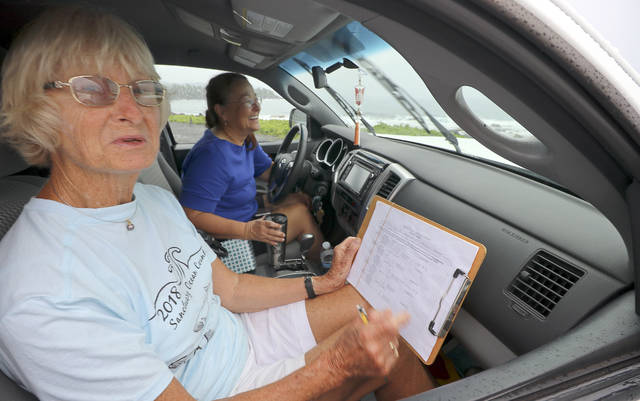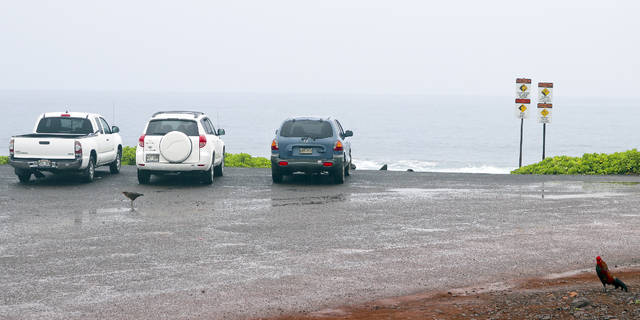LIHUE — Lani Tamanaha-Broadbent said the weather Saturday was ideal for whale watching from the shoreline.
“The seas are calm,” she said. “You can see the whales if they do any activity. There are a lot of boats out there.”
Tamanaha-Broadbent shared the cab of her pickup with Marga Goosen at the Ahukini Landing site for the Sanctuary Ocean Count taking place at 12 reporting sites on Kauai. This was the third — and final — count taking place for the 2018 whale season.
“We saw some red-footed boobies,” Goosen volunteered from the group of three counters, which was a decrease from the normal dozen-plus counters who show up when the weather is ideal. “And a lot of boats.”
More than 440 volunteers gathered data from the shores of Oahu, Kauai and Hawaii Island during the final event of the 2018 Hawaiian Islands Humpback Whale National Marine Sanctuary Ocean Count, said Cindy Among-Serrao, the Sanctuary Ocean Count project coordinator from the Oahu office. Data was collected from 43 sites on the three islands, including the dozen from Kauai.
“Weather conditions were great for viewing whales on Hawaii Island, but were unfavorable for viewing whales on Oahu and Kauai,” Among-Serrao said. “A total of 34 whale sightings were seen during the 11 to 11:15 a.m. time period, the most of any time period throughout the day.”
Jean Souza, the sanctuary coordinator on Kauai, reported an average of one sighting during a 15-minute count period, a decrease from the three average in January, and two average during the February counts.
“Today’s Sanctuary Ocean Count on Kauai was adversely affected by the widespread rain that blanketed Kauai this morning,” Souza said. “Two sites — Lumahai and Mahaulepu-Makawehi Point — were not used because of the rainy conditions. Five sites — The Cliffs at Princeville, Crater Hill, Kapaa Lookout, Ahukini Landing and Kaiwa Point — were eventually rained out. Weather conditions like today’s rain and vog can affect the sighting of whales.”
Sites on Kauai reporting a good number of sightings included the Kilauea Point, Crater Hill and the Pacific Missile Range Facility at Mana where each site saw two whales during a 15-minute count period.
Souza said other marine life reported during the count included honu, dolphins and many seabirds.
“Seventy-six very dedicated and hardy community volunteers, nearly half of the 145 volunteers for the February count, participated in Saturday’s count,” Souza said. “The rain also affected the number of public members out and about along the coastlines. Those who received education at the count numbered 76, less than half of the February count where 271 people got information.”
Souza said the sanctuary count provides a “snapshot” of the whales visible from shore during a four-hour time period on the final Saturday during the peak months of January, February and March.
“The whales are not evenly distributed in the ocean,” Souza said. “Humpback whale sightings on Kauai during the 2018 January and February counts were low, but this is not an indication that the number of whales around Kauai were low. Many of the whales observed in the first two months were offshore and not easily visible from shore. At those distances, the sighting of calves are also reduced. Nonetheless, based on the anecdotal reports I have received, there were many humpback whales sighted — especially during March — on Kauai during this whale season.”
John Burger, the site leader at the Kapaa Lookout, which was partially rained out, summed up the activity succinctly.
“The whales are out there,” Burger said. “It’s just that we can’t see them.”
•••
Dennis Fujimoto, staff writer and photographer, can be reached at 245-0453 or dfujimoto@thegardenisland.com.



